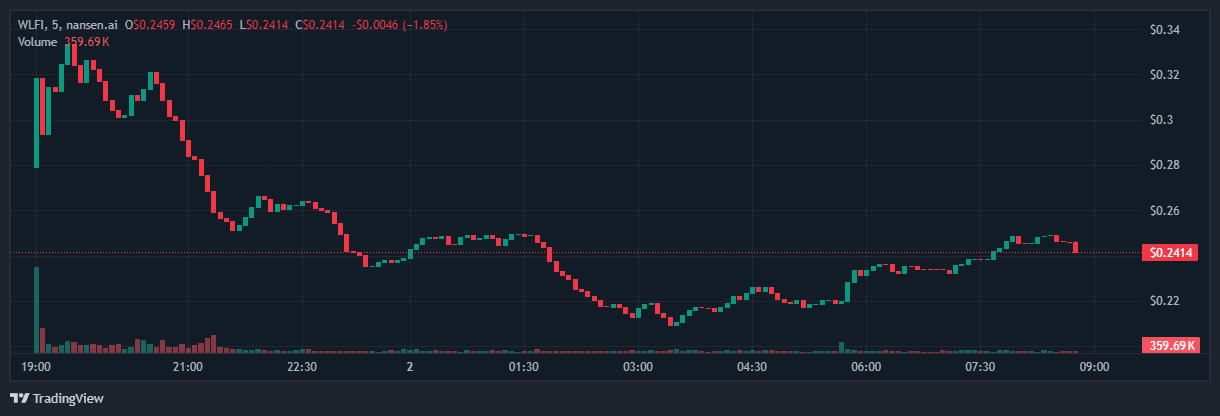World Liberty Financial’s WLFI buyback and burn proposal would use 100% of protocol-owned liquidity (POL) fees to purchase WLFI on the open market and permanently burn the tokens, reducing circulating supply and increasing relative ownership for long-term holders.
-
100% of POL fees proposed to buy WLFI and burn
-
Proposal aims to link platform usage to token scarcity and benefit committed holders.
-
WLFI circulating supply rose by 24.6B after a recent unlock; current circulation and fee estimates will determine burn impact.
WLFI buyback and burn proposal: World Liberty Financial proposes using 100% of protocol fees to buy and burn WLFI — vote, monitor fee generation, and assess supply impact.
What is the WLFI buyback and burn proposal?
The WLFI buyback and burn proposal would channel 100% of protocol-owned liquidity (POL) fees across Ethereum, BNB Chain and Solana into market purchases of WLFI, then send purchased tokens to a burn address. The goal is to reduce the circulating supply and raise the relative stake of committed long-term holders.
How would protocol fees fund the WLFI buyback and burn?
World Liberty Financial governance proposes using all fees generated by the protocol’s own liquidity positions to buy WLFI from short-term sellers. Fee volumes will determine the scale of the burn.
Key figures: WLFI’s circulating supply stands at 27.3 billion of 100 billion total supply, with a reported market capitalization of $6.6 billion. A recent unlock added 24.6 billion tokens to circulation and boosted founder holdings to an estimated $5 billion.
The proposal frames buyback-and-burn as a mechanism to remove tokens from circulation held by participants not committed to WLFI’s long-term growth, increasing the relative ownership of committed holders.
Proposal proponents emphasize a full-burn approach rather than splitting between treasury operations and burns. WLFI ambassador “Tespmoore” commented that alternative splits were considered but the governance text favors an all-in burn strategy.
There are open questions: estimated fee yields are unclear, making precise burn forecasts difficult. Governance has not specified a contingency for emergency treasury needs if all POL fees are committed to burning.
NOW: World Liberty Financial community proposes using 100% of protocol-owned liquidity (POL) fees for $WLFI buyback and permanently burning it, to reduce circulating token supply. pic.twitter.com/q4owImHlbP — Cointelegraph, September 1, 2025
Why did a big unlock increase founder holdings?
A large WLFI token unlock on Monday released 24.6 billion tokens to circulation, raising the circulating total to 27.3 billion. The unlock increased the reported value of the Trump family’s holdings to approximately $5 billion based on prevailing prices at the time.
The project previously said founders’ holdings would initially remain locked; the unlock details changed circulating dynamics and spurred governance debates over supply management.
WLFI price performance and market reaction
WLFI debuted on exchanges and experienced significant volatility. Prices fell from a peak near $0.331 to a low of $0.210, a drop of roughly 36%, before stabilizing around $0.229 at the time of reporting. Short-selling and the large unlock contributed to downward pressure.

WLFI price tanks after debut on exchanges. Source: Nansen
Frequently Asked Questions
How much of protocol fees will be used for buybacks?
The governance proposal suggests using 100% of protocol-owned liquidity fees to buy WLFI and burn it. The plan does not allocate a portion for treasury reserves, which raises questions about emergency funding options.
Will burning WLFI guarantee higher prices?
Burning reduces supply but does not guarantee price increases. Price impact depends on market demand, fee volumes used for buys, and broader sell pressure. A sustained increase requires persistent fee generation and user activity on the protocol.
Key Takeaways
- Full-fee burn proposed: Governance recommends 100% of POL fees be used to buy and burn WLFI.
- Supply shifted by unlock: A 24.6B token unlock raised circulating supply to 27.3B and increased founder holdings.
- Impact depends on fees: The burn’s effectiveness hinges on actual fee generation and contingency planning for the treasury.
Conclusion
This proposal directly ties platform usage to token scarcity by allocating all protocol-owned liquidity fees to WLFI buybacks and burns. The plan aims to reward long-term holders and reduce circulating supply, but its ultimate effectiveness will depend on fee volumes, governance approval, and contingency arrangements. Monitor governance votes and protocol fee reports for the next steps.
